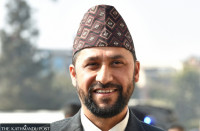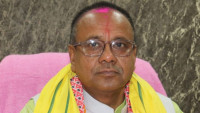National
Former finance ministers describe budget as traditional with nothing new to offer
With more focus on managing costs and cash flows, most of its goals are challenging and difficult to achieve, they say.
Sangam Prasain
Former finance ministers and economists have labelled the budget for the next fiscal year 'traditional' as it is focused on managing costs and cash flows.
They said the government's annual financial plan presented to Parliament on Thursday contained several drawbacks, and that most of its goals were challenging and difficult to achieve.
Finance Minister Yuba Raj Khatiwada has unveiled a Rs1.47 trillion budget for fiscal 2020-21, about 4 percent smaller than the last one. It has earmarked Rs948 billion for recurrent expenditure, Rs352 billion for capital expenditure, and Rs172 billion for financing provisions.
When most global economies are trimming their growth projections due to the depression caused by the Covid-19 pandemic, Nepal has bucked the trend with Khatiwada setting a highly ambitious growth target of 7 percent, a tall order even in the best of times.
“The Covid-19 pandemic was the right time for the finance minister to change the challenge into an opportunity. But he too has been beset by divided loyalties. The budget does not address the needs of the people, and has unjustly accorded a lower priority to some sectors that need massive investment,” said former prime minister and finance minister Baburam Bhattarai, speaking at a post-budget webinar interaction with financial journalists on Friday.
Divided loyalty means Khatiwada has to follow the party's mandate while heeding his scholarly reasoning applied to a free market regime. “If we can’t dream, we are left behind.”
The budget presented by Khatiwada is neither focused on socialism that benefits society as a whole nor on capitalism that promotes free market conditions. “He is in the middle. That’s ‘Asanism’—standing in the middle of Asan bazaar,” said Bhattarai.
“Will the budget help in the creation of jobs? Is it in the interest of farmers? Is it a development-oriented budget?” he questioned. “It would have been better to deposit Rs5,000 each into the bank accounts of poor families at a time of crisis than ask unemployed people to uproot grass and pay them,” said Bhattarai.
He said that this type of budget would neither promote consumption nor help the economy grow. “In difficult situations, the government should not hesitate to ask for loans from the international community. It should not worry about the size of the budget because pumping money into the economy will generate jobs and increase private sector confidence,” he said.
"The government had an opportunity to become bold and ambitious by bringing a budget of over Rs1.7 trillion in the context of the pandemic. But it is yet another traditional budget that is focused on managing costs and cash flows.”
Another former finance minister Ram Sharan Mahat said that the economy would sink further into depression—maybe for the next six to eight months—and that the government had targeted achieving a 7 percent growth rate in the next fiscal year.
“The budget is full of promises particularly to address the labour and agriculture sectors and skill development, but it will be challenging to get results.”
Former Finance Minister Surendra Pandey said that Nepal had achieved an average 7 percent growth in the past three years, and that had happened in a normal situation.
“In this crisis and with limited resources, a 7 percent growth is unattainable,” he said. But he lauded the government for according priority to the health, agriculture and labour sectors. “The government should be cautious because demand is suppressed; and to increase consumption, it should develop a separate strategy,” he said.
Citing travel leave concession as an example, Pandey said that providing paid leave to government employees to visit different parts of Nepal was forced demand intended to keep hotel and restaurant businesses afloat.
Shankar Sharma, former vice-chairman of the National Planning Commission, said that the budget was a surprise as it was concentrated on achieving economic growth rather than offsetting the Covid-19 pandemic.
“Remittance inflow has already dropped by 20 percent in two months, and it could fall by 50 percent. The government has announced bringing back long stranded Nepalis from India and other countries. This shows that demand for food will rise,” he said.
“The budget contains no immediate measures to feed them,” said Sharma, adding that the country may face a fertiliser shortage ahead of the upcoming paddy planting season. “There are several drawbacks that the budget has not addressed.”
Economist Govinda Nepal said that as the budget had not dealt with key sectors due to its limitation, the government needed to form a separate task force and review them. “The impact of the virus is likely to stay for the next six-eight months, and the economy will suffer further.”
In a separate post-budget interaction with journalists, Finance Minister Khatiwada said that the budget had been introduced cautiously, and that its results would be visible in another fiscal year.
“The budget allocation for the agriculture sector has been hiked significantly. The budget allocated for the Agriculture Ministry looks small, but that’s for the ministry only. He said that the government would be pumping Rs60 billion into various relief programmes. More than Rs20 billion has been allocated to generate jobs.
“There are so many programmes to generate jobs and retain jobless workers. In no budget in Nepal’s history has so much focus been given to workers,” said Khatiwada.
“As revenue will dry up and we will need to cover the budget deficit, we are relying heavily on the support of donors because they have pledged to help us.”




 10.12°C Kathmandu
10.12°C Kathmandu















